Related Research Articles
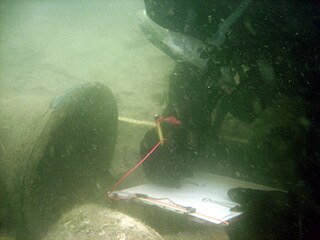
Maritime archaeology is a discipline within archaeology as a whole that specifically studies human interaction with the sea, lakes and rivers through the study of associated physical remains, be they vessels, shore-side facilities, port-related structures, cargoes, human remains and submerged landscapes. A specialty within maritime archaeology is nautical archaeology, which studies ship construction and use.
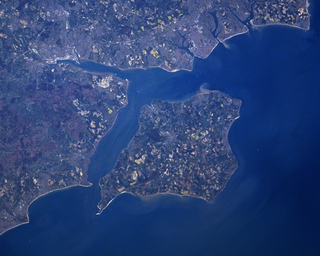
The Solent is a strait between the Isle of Wight and mainland Great Britain; the major historic ports of Southampton and Portsmouth lie inland of its shores. It is about 20 miles long and varies in width between 2+1⁄2 and 5 mi, although the Hurst Spit which projects 1+1⁄2 mi (2.4 km) into the Solent narrows the sea crossing between Hurst Castle and Colwell Bay to just over 1 mi (1.6 km).
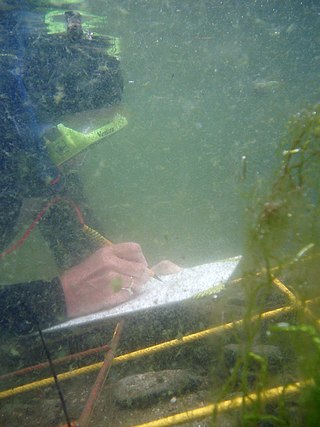
Underwater archaeology is archaeology practiced underwater. As with all other branches of archaeology, it evolved from its roots in pre-history and in the classical era to include sites from the historical and industrial eras.

A megalith is a large stone that has been used to construct a prehistoric structure or monument, either alone or together with other stones. There are over 35,000 in Europe alone, located widely from Sweden to the Mediterranean sea.

The Medway Megaliths, sometimes termed the Kentish Megaliths, are a group of Early Neolithic chambered long barrows and other megalithic monuments located in the lower valley of the River Medway in Kent, South-East England. Constructed from local sarsen stone and soil between the 4th and 3rd millennia BCE, they represent the only known prehistoric megalithic group in eastern England and the most south-easterly group in Britain.

Pantelleria, known in ancient times as Cossyra or Cossura, is an Italian island and comune in the Strait of Sicily in the Mediterranean Sea, 106 kilometres southwest of Sicily and 68 km (35 nmi) east of the Tunisian coast. On clear days Tunisia is visible from the island. Administratively Pantelleria's comune belongs to the Sicilian province of Trapani.
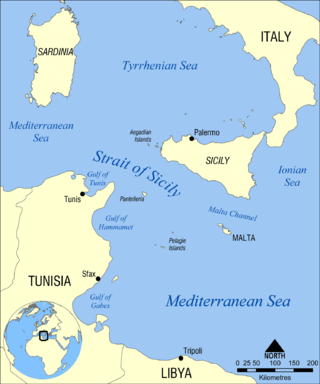
The Strait of Sicily is the strait between Sicily and Tunisia. The strait is about 145 kilometres (90 mi) wide and divides the Tyrrhenian Sea and the western Mediterranean Sea, from the eastern Mediterranean Sea. The maximum depth is 316 meters (1,037 ft). The island of Pantelleria lies in the middle of the strait.

Graham Island is a submarine volcano in the Mediterranean Sea near the island of Sicily that has, on more than one occasion, risen above the surface of the Mediterranean via volcanic action and soon thereafter been washed away. Since 300 BC this cycle of events has occurred four times.

Franchthi Cave or Frankhthi Cave is an archaeological site overlooking Kiladha Bay, in the Argolic Gulf, opposite the village of Kiladha in southeastern Argolis, Greece.
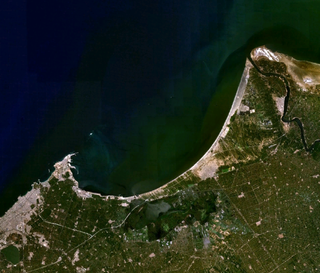
The Abū Qīr Bay is a spacious bay on the Mediterranean Sea near Alexandria in Egypt, lying between the Rosetta mouth of the Nile and the town of Abu Qir. The ancient cities of Canopus, Heracleion and Menouthis lie submerged beneath the waters of the bay. In 1798 it was the site of the Battle of the Nile, a naval battle fought between the British Royal Navy and the navy of the French First Republic. The bay contains a natural gas field, discovered in the 1970s.

The Yonaguni Monument, also known as "Yonaguni (Island) Submarine Ruins", is a submerged rock formation off the coast of Yonaguni, the southernmost of the Ryukyu Islands, in Japan. It lies approximately 100 kilometres east of Taiwan.

Fagnano Lake, also called Lake Cami, is a lake located on the main island of the Tierra del Fuego archipelago, and shared by Argentina and Chile. The 645 km2 lake runs east–west for about 98 kilometres, of which 72.5 km (606 km2) belong to the Argentine Tierra del Fuego Province, and only 13.5 km (39 km2) belong to the Chilean Magallanes y la Antártica Chilena Region. It has a maximum depth of 449 meters. The southern bank is steep compared to the northern, and expands in a considerably wide and flat piedmont from which both levels of the plateaus can be appreciated. From its western end, the Azopardo River drains towards the Almirantazgo Fjord. On its eastern end is the town of Tolhuin. The lake is located in a pull-apart basin developed along the Magallanes–Fagnano Fault zone.
Franck Goddio is a French underwater archaeologist who, in 2000, discovered the city of Thonis-Heracleion 7 km (4.3 mi) off the Egyptian shore in Aboukir Bay. He led the excavation of the submerged site of Canopus and of the ancient harbour of Alexandria, including Antirhodos Island. He has also excavated ships in the waters of the Philippines, significantly the Spanish galleon San Diego.
This article describes several characteristic architectural elements typical of European megalithic structures.

Doggerland was an area of land in Northern Europe, now submerged beneath the southern North Sea. This region was repeatedly exposed at various times during the Pleistocene epoch due to the lowering of sea levels during glacial periods, though the term "Doggerland" is generally specifically used for this region during the Late Pleistocene and Early Holocene. During the early Holocene, the exposed land area of Doggerland stretched across the region between what is now the east coast of Great Britain, the Netherlands, the western coast of Germany and the Danish peninsula of Jutland. Between 10,000 and 7,000 years ago, Doggerland was inundated by rising sea levels, disintegrating initially into a series of low-lying islands before submerging completely. The impact of the tsunami generated by the Storegga underwater landslide c. 8200 years ago on Doggerland is controversial. The flooded land is known as the Dogger Littoral. Doggerland was named after the Dogger Bank, which formed a highland region that became submerged later than the rest of Doggerland.
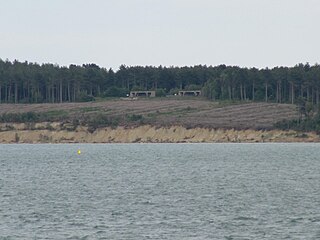
Bouldnor Cliff is a submerged prehistoric settlement site in the Solent. The site dates from the Mesolithic era and is in approximately 11 metres of water just offshore of the village of Bouldnor on the Isle of Wight in the United Kingdom. The preservation of organic materials from this era that do not normally survive on dry land has made Bouldnor important to the understanding of Mesolithic Britain, and the BBC Radio 4's Making History programme described it "probably Europe's most important Mesolithic site" albeit concealed under water.

Gavrinis is a small island in the Gulf of Morbihan in Brittany, France. It contains the Gavrinis tomb, a Neolithic passage tomb built around 4200–4000 BC, making it one of the world's oldest surviving buildings. Stones inside the passage and chamber are covered in megalithic art. It is likened to other Neolithic passage tombs such as Barnenez in Brittany and Newgrange in Ireland.
Michael Alexander Arbuthnot is an archaeologist, instructor and archaeological filmmaker.
Zvi Ben-Avraham is an Israeli earth scientist, specializing in geophysics of the Mediterranean Sea and the Dead Sea Transform. He is currently a professor of Geophysics at Tel Aviv University. Ben-Avraham was awarded the Israel Prize in 2003. He is member of several national academies and fellow of geological societies.

The Gozo Phoenician shipwreck is a seventh-century-BC shipwreck of a Phoenician trade ship lying at a depth of 110 meters (360 ft). The wreck was discovered in 2007 during a sonar survey off the coast of Malta's Gozo island. Since 2014 it has been the object of a multidisciplinary project led by University of Malta along with many other national and international entities. The Gozo shipwreck archaeological excavation is the first maritime archaeological survey to explore shipwrecks with divers beyond a depth of 100 meters (330 ft).
References
- ↑ "9,300-Year-Old Stonehenge-Style Monolith Found in Mediterranean Sea | Archaeology | Sci-News.com". Sci.News: Breaking Science News. 2015-08-12. Retrieved 2022-09-14.
- 1 2 Lodolo, Emanuele; Ben-Avraham, Zvi (September 2015). "A submerged monolith in the Sicilian Channel (central Mediterranean Sea): Evidence for Mesolithic human activity". Journal of Archaeological Science: Reports. 3: 398–407. doi:10.1016/j.jasrep.2015.07.003.
- 1 2 Laura Geggel (August 13, 2015). "Ancient Monolith Suggests Humans Lived on Now-Underwater Archipelago".
- ↑ Gemma Tarlach (November 30, 2015). "Mysterious Monolith in the Sicilian Channel". Discover.
- ↑ "Monolith Discovered in the Sicilian Channel". Archaeology Magazine. August 7, 2015.